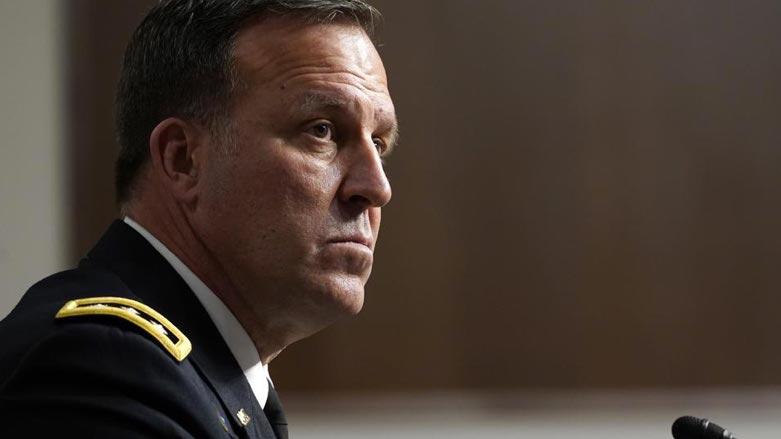CENTCOM: ISIS, Iran are two big threats in region

WASHINGTON DC, United States (Kurdistan 24) – On Thursday, Gen. Michael Kurilla, head of U.S. Central Command, briefed journalists on the situation in the Middle East and identified ISIS and Iran as the two biggest threats to the U.S. and its allies in the region.
U.S. Military Focus Shifting from Middle East back to Major Powers
At the same time, Kurilla also noted that the past two decades—since the 9/11 attacks—have been something of an anomaly. Historically, the U.S. military has focused on challenges from other major powers. That changed, suddenly, after the 9/11 attacks. But that has now ended, and the US military has reverted to historical norms.
“Over the past 20-plus years, CENTCOM has been the focus of much of the U.S. Department of Defense,” Kurilla said. “That was an unusual time in American history,” and “we were fighting two wars at the same time”—i.e. in Afghanistan and Iraq.
“Those wars have concluded,” he stated, “and now we, understandably, have downsized our force posture in the Middle East.”
“We don’t have the enormous number of planes, ships, troops, and air defense systems that we had in the region just five years ago,” he continued. Instead, CENTCOM has had to cultivate “deep, abiding partnerships” with local parties “that can serve as a hedge against threats in the region, while deterring Iran from its worst, most destructive behavior.”
ISIS Threat in Iraq
“While ISIS is significantly degraded in Iraq and Syria, the group does maintain the capability to conduct operations in the region, and we know the group has the desire to strike outside of the region,” Kurilla explained.
Indeed, there appears to be a recent uptick in ISIS attacks in Iraq, with four occurring over the past week:
- Nine federal Iraqi police were killed in southern Kirkuk on Sunday.
- At least eight people were killed in an ISIS attack in a rural area of Diyala province on Monday.
- On Tuesday, the UN Security Council condemned the two attacks and expressed condolences to the families of the latest ISIS victims.
- On Wednesday, one Iraqi soldier was killed and two others were wounded in an ISIS attack in Kirkuk Province.
- On Thursday, ISIS killed a policeman and injured four others in an attack at the Kobani checkpoint on the border of Kirkuk Province.
Kurilla did not mention the increase in ISIS attacks, let alone explain them, but he did affirm that ISIS remained a threat.
ISIS Threat in Syria
One of Kurilla’s major concerns is the possibility of a new Turkish assault on the Syrian Democratic Forces (SDF), America’s main partner in Syria in the fight against ISIS.
Kurilla explained that US forces in Syria “continue to put pressure on ISIS” and “just this past week, we conducted a series of raids with our Syrian Democratic Force partners,” noting that the raids had led to the capture of “numerous ISIS operators,” including “a senior leader.”
But operations with the SDF were suspended after Turkey began attacking the group last month, claiming the SDF was behind the Nov. 13 bombing in Istanbul that killed six people. The charge was implausible, and it was more likely that ISIS was responsible.
Read More: US: Turkish-backed group killed head of ISIS last month—throws new light on Istanbul bombing
US officials, including Secretary of Defense Lloyd Austin, protested strongly to their Turkish counterparts about the attacks on the SDF. Eventually, Turkey relented, and on Dec.9, joint operations “resumed in full” as the Pentagon Press Secretary later explained.
Read More: US confirms resumption of operations with SDF in northeast Syria
But the danger of a renewed Turkish assault remains. Responding to a reporter’s question about a possible Turkish incursion, Kurilla said, “I am very, very concerned about that, because that can destabilize the region and call our SDF partners off of the prisons.”
“They have about 28 prisons across Syria,” he said. Last January a prisoner escaped from Hasakah’s al-Sina’a prison, he added. While that was not related to any Turkish action, it may have been an effort by Damascus and Moscow to pressure the SDF.
Read More: US-led Coalition backs SDF in Hasakah; Syrian regime backs ISIS?
Iranian Threat
US forces are in Iraq and Syria to counter the ISIS threat, but Iran is also a threat, Kurilla explained.
“Iran continues to undermine regional security and stability through militia groups, ballistic missile capabilities, UAVs, and routine threats to international waterways,” he stated. Iran “continues to spread chaos through violent proxy groups funded by Tehran,” which “routinely strike at American troops and our partners in Iraq and Syria.”
For a long time, the Biden administration made only limited efforts to counter that threat. Its priority was renewing the 2015 nuclear deal. However, after Tehran began to provide some of those very same weapons—particularly UAVs—to Russia for use in Ukraine, it adopted a much tougher position.
Indeed, it contributed to the remarkable conclusion, articulated last month by President Joe Biden himself, that the nuclear deal was “dead.”
Read More: Joe Biden: Iranian nuclear deal is “dead”
